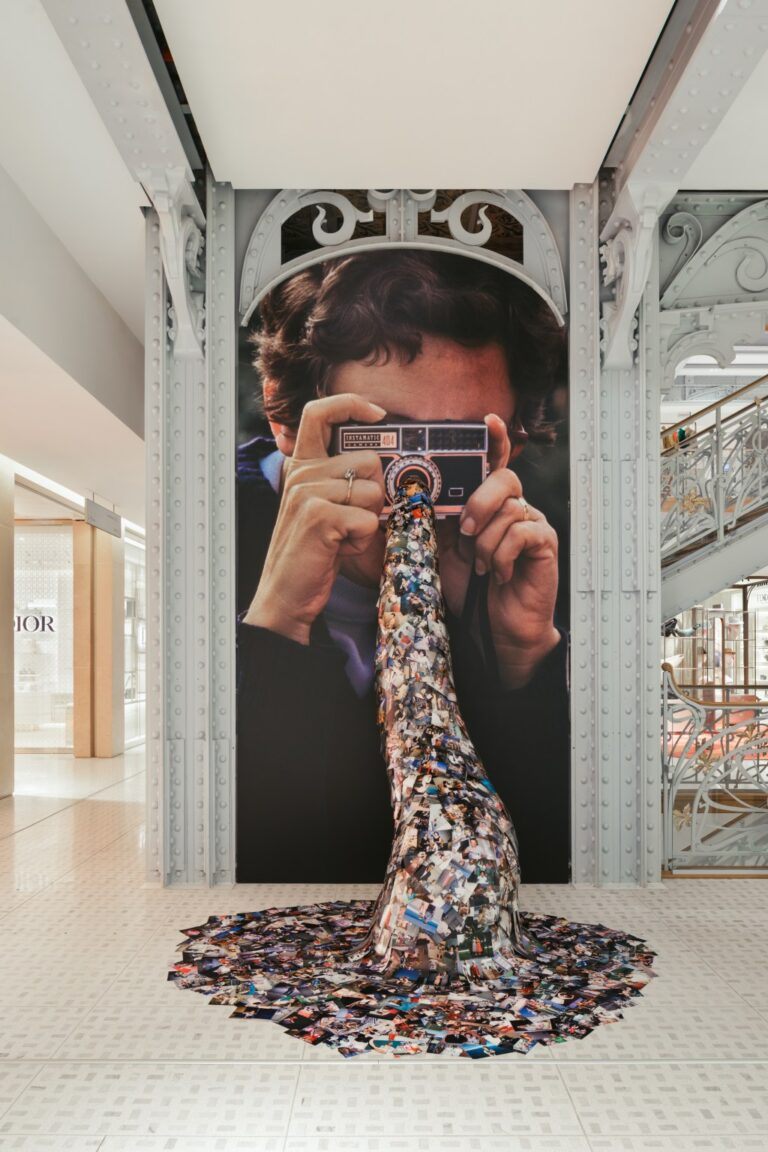Paris — The Anonymous project is on display among a number of famous brands at Samaritaine Paris as part of a new exhibition at the DFS-owned department store.
Beneath the famous arched staircase, surrounded by luxury handbags, British artist Lee Schulman's found photography installation features hundreds of vintage slides encased in glass, thick wood or covering the banks of an elevator. It has been blown up to a gigantic size.
Elsewhere, stacks of slides spill out from the walls, creating a cascade of images across the marble shop floor.
A handbag came in handy. When setting up the installation at 3 a.m., Schulman needed a straight line and a means of measurement. Without a yardstick, he picked up his two Pradas to use as a reference.
“I love it when worlds collide,” Schulman said, showing off a festive manicure featuring the blue, white and red French flag on one side and the green, white and red Italian flag on the other.
The double tricolor is a homage to the twin structures of the exhibit. It is part of a joint project designed by Samaritaine Paris and DFS, part of LVMH Moët Hennessy Louis Vuitton, parent company of T Fondaco dei Tedeschi in Venice, to create a series of urban exchanges. .
The Parisian store showcase was transformed into a vision of Venice with architectural displays, and as part of the project the Venice window was configured as a Parisian location, which also gave rise to culinary demonstrations and sowed the seeds of cross-pollination between the brands. . Last month, Italian brand La Doublege opened its first standalone shop-in-shop in Samaritaine Paris with a capsule collection.
Travel retailer DFS wanted to bridge the cultures of the two cities in which it has stores. “Taking advantage of this parallelism and contrast has been in our minds for a long time,” said Eleonore de Boisson, president of Europe, Middle East and Africa.
“These are two incredibly iconic and iconic buildings in their respective cities: Venice, which offers clients a very Venetian experience with gastronomy and local brands, and Romanticism in the heart of Paris. “I wanted to show the similarities with the city,” she added.
If a department store feels like an unusual place to display vintage found photos, Schulman says, it encapsulates the changing nature of art.
“Warhol said the best thing ever, that in the future every gallery is going to be a supermarket, and every supermarket is going to be a gallery. I don’t think it’s far away,” he said. “Put it on the street, put it in the mall, put it wherever you need it. I think the more the better.”

Anonymous Project display in the handbag department.
People of all ages come and go in department stores. “If you want to show images of everyday life, there's no better place than this. It's the kind of place where life happens,” he said. “It's kind of counter-directional in a way. But maybe that's a good thing. I've always said I want to be somewhere you don't expect me to be, and that's what this place is like.” What could be more boring than being in a gallery with white walls?”
The intimate nature of the discovered photographs should also call into question the public's view of art and artists, as the project blurs the lines between those who can be called amateurs and professionals. Mr. Shulman argued. These images were taken by members of the public who were pointing their lenses at their friends and family.
“It's very emotional,” he said, adding that the message was a demonstration of care and value, especially at a time when film was rarer and more difficult to develop. “[Photography] It’s so disposable these days…I love the imperfections in life. These show reality. “I think we're living in some kind of sub-reality right now,” he said of today's world, full of sophisticated filters and AI-powered images.
“They have a message that they want to convey to us today. They cherish this idea of a big family, and we all have to work on something a little bit bigger and not just the little things that we're focused on. I belong,” he said.
The image is unprocessed and has saturated colors. He also said the images were time capsules, capturing fashion moments in which people wore more formal attire for everyday events.

Samaritaine Image from an anonymous project in one of the elevator banks in Paris.
For Samaritaine Paris, this is part of a strategy to position itself as a center for culture and art, cemented with a series of events including last season's hair exhibition with Charlie Le Minde.
“It's an experience. It gives people a reason to come back and sparks their curiosity. We work to surprise and delight our customers and provide them with an experience that's more than just shopping.” Mr de Boisson said. We have a dedicated experience team that plans exhibitions and sources coordinated products each year.
De Boisson said most non-Chinese tourists have returned, with U.S. tourists at “about double the 2019 level.” The number of Chinese tourists has begun to stabilize and return this year, and is expected to reach pre-pandemic numbers around 2025.
Meanwhile, the department store is attracting not only French tourists but also an increasing number of local residents shopping in Paris.
The Anonymous Project exhibition will run until April 23rd at Samaritaine, Paris, and will open at T. Fondaco dei Tedeschi on April 17th in conjunction with the Venice Art Biennale, with some duplicate works on display. and several new works will be introduced in the vast atrium there.
In Venice, 12 large images are printed on tissue to add transparent elements to reflect the feel of the original slides. There will also be a dedicated exhibition space with a 360-degree installation, in which different images are arranged in parallel, creating the illusion of a continuous horizon. It will run until November 24th.


